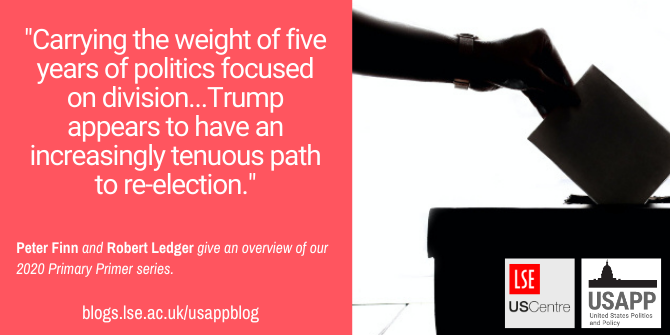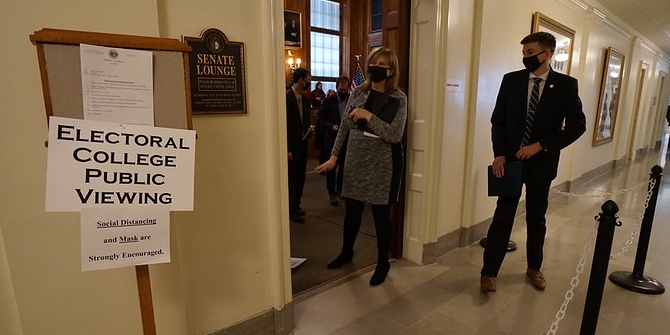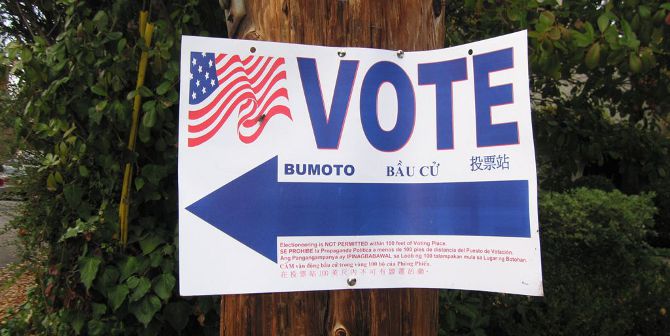
 Across more than 50 articles on this blog, the Primary Primers series has documented, firstly, the ins and outs of the Democratic Party primary process and, secondly, the intersection between the 2020 presidential race and the COVID-19 pandemic. Series co-curators Peter Finn and Robert Ledger predict a victory for Democratic nominee Joe Biden, which will leave him, and his Vice-Presidential pick Kamala Harris, with the immediate tasks of grappling with the pandemic, re-engaging the federal government on climate change and dealing with racial inequities.
Across more than 50 articles on this blog, the Primary Primers series has documented, firstly, the ins and outs of the Democratic Party primary process and, secondly, the intersection between the 2020 presidential race and the COVID-19 pandemic. Series co-curators Peter Finn and Robert Ledger predict a victory for Democratic nominee Joe Biden, which will leave him, and his Vice-Presidential pick Kamala Harris, with the immediate tasks of grappling with the pandemic, re-engaging the federal government on climate change and dealing with racial inequities.
- This article is part of our Primary Primers series curated by Rob Ledger (Frankfurt Goethe University) and Peter Finn (Kingston University). Ahead of the 2020 election, this series explores key themes, ideas, concepts, procedures and events that shape, affect and define the US presidential primary process. If you are interested in contributing to the series contact Rob Ledger (ledger@em.uni-frankfurt.de) or Peter Finn (p.finn@kingston.ac.uk).
In February 2019 we launched the Primary Primers series to explore key themes, ideas, concepts, procedures and events that shape, affect and define the US presidential primary process. Since then, the series has benefited from the work of dozens of contributors (many of whom have written numerous posts) and has recently reached 50 articles. Along the way, the series has racked up tens of thousands of page views (with posts regularly featuring among the most read pieces on the site and a post from Barbara Norrander on Super Tuesday featuring in the site’s most read pieces of 2019), had posts republished by other publications and translated into other languages.
The series launched as a large field of pretenders to the Democratic nomination was coalescing in the aftermath of the 2018 midterm elections, and as a Trump induced government shutdown that lasted for more than a month was, just about, fading into the rear view mirror. The Democratic field in early 2019 was incredibly diverse. It included numerous Senators, former governors, entrepreneurs, the Mayor of a small town and a former Vice President and Senator.
Despite this diversity the nomination was won by former Vice President Joe Biden, a white male in his mid-seventies. Perhaps in part because of this, Biden has nominated his former opponent Kamala Harris, who is part Indian American part African American, in the Vice-Presidential slot on his ticket. Harris, it should be noted, is, as a US Senator and the former Attorney General of California, no political lightweight.
A Frantic Two Years
Since early 2019, US politics has continued at the frenetic pace that characterized Trump’s first two years in power. Among other significant events, the last two years have seen the release of the Mueller report into Russian interference in the 2016 US presidential election, the impeachment and acquittal of Trump and two seats becoming available on the US Supreme Court. Likewise, the campaign to become Trump’s Democratic challenger featured many twists and turns including Harris attacking Biden for his past relationships with segregationist Senators, allegations of inappropriate behaviour against Biden, and the generation of campaign specific cultural signals and alignments (remember the #YangGang?). Finally, since spring this year US politics, presidential or otherwise, has been shaped by the US government’s botched responses to the COVID-19 pandemic.
COVID-19
With almost a quarter of a million confirmed deaths, and likely almost 10 million cases being confirmed by election day, COVID-19 will be the topic on the ballot. The pandemic continues to rage across the US, with 80,000 cases confirmed on a single day for the first time on October 23rd, whilst, with death rates rising, daily deaths appear poised to rise above a thousand a day for the first time since mid-August in the coming weeks.
Beyond the almost incomprehensible numbers of infections and deaths, the pandemic has led to issues with the provision of other aspects of medical care (in a system already packed full of problems despite the spending of upwards of 15 percent of US GDP on health care), millions and millions of job losses and the perpetuation of partisan divisions.
COVID-19 first appeared in the series in a piece by Kevin Fahey on March 11th. Though this piece was centered around the place of Ohio within the presidential race, it also touched on the potential economic effects of the pandemic. Since then, COVID-19 has been an important theme in the series. While by no means every piece since has been about the pandemic, it is fair to say it has been important to many, and important context for others. Articles that have focused on COVID-19 include a piece by us that considered how COVID-19 could impact the November election (spoiler, our predictions stand up quite well), two posts from Wendy Scattergood that explored the contestations, confusion and controversies that swirled around the primary process in Wisconsin, a piece by James D. King that examined the potential effects of moving the Democratic Convention, and a post from one of us that reflected on Trump testing positive for COVID-19.

Image credit: Element5 Digital on Unsplash
Race and Inequality
From late-May onwards, issues around race, sparked by the police killing of George Floyd in Minneapolis but drawing from decades of frustration about racial inequality that was reflected in higher COVID-19 death rates among African Americans, were layered onto the politics and pain of the pandemic.
Posts that have examined related issues include a profile of Georgia by Will Rooke from October 2019 that, among other things, explored the effects of the great reverse migration, whilst last month Emilia Belknap explored how the politics around the nomination of Kamala Harris as a Vice-Presidential Candidate relate to her identity as an African American female. We are particularly keen to explore these issues further in future, so please do get in touch if you are interested in expanding the series in this direction.
Gender
In 2016, some opposition to Hillary Clinton was based on her gender, with Trump unafraid to engage in misogynistic attacks against Clinton and others. This was not helped by the appearance of the Access Hollywood tape in October 2016, on which Trump boasted about engaging in sexual assault.
Unsurprisingly, gender has been a continual theme since Trump’s election. The day after his inauguration, the Women’s March drew large crowds voicing opposition to Trump in Washington D.C. and cities around the world. Policy wise, the Trump administration (and its male dominated cabinet) has restricted the health care choices available to females in the US over the last four years by, among other things, blocking funding for family planning. Depressingly predictably, misogynistic (and racist) attacks against Harris, meanwhile have proliferated.
In the Primary Primers series Amy Tatum has explored the double-bind (‘the need [of female candidates] to show they possess the agentic traits required for leadership but also the communal attributes expected of them as women’) that faced female presidential candidates such as Harris. Looking forward, Samantha Pettey demonstrated why 2020 may see record numbers of females elected to the US House of Representatives.
Decreasing Returns on Division?
Carrying the weight of five years of politics focused on division (though it is important to note Trump is a particularly disturbing symptom rather than cause here), Trump appears to have an increasingly tenuous path to re-election. The playbook used against targets of his attacks has generally remained constant (an individual or group are identified for derision, Trump unloads a Twitter storm often backed up by verbal attacks and then his followers pile on), but appears to be generating ever decreasing returns.
With fewer and fewer Republicans prepared to tie their flag to his mast, Trump appears to be hemmed into a dysfunctional White House and egged on by a seemingly shrinking circle of true believers. As Mark Shanahan noted in a recent post ‘the decision on who wins on November 3rd may already be out of Donald Trump’s hands’. Our in-house series poll analyst, Ronald Ranta, meanwhile, argued in a very popular piece in August that ‘Trump is about to lose, and it won’t be close.’
Out of Trump’s Hands?
Biden has a large lead in the polls, with tens of millions of votes cast in early voting. If Trump is to stay as president, his path to victory appears to run, as it did in 2016, through a small number of swing states. Trump lost the popular vote four years ago by almost three million votes, securing victory in the Electoral College. If a relatively small number of voters in Pennsylvania, Michigan and Wisconsin had voted differently, then Clinton would have been president. Trump’s chances of re-election appear to rest on similar margins.
If Biden, who has run an explicitly big-tent campaign parked directly at what is perceived as the middle ground of US politics, wins a decisive victory, then Trump will be out of the White House come late January (perhaps to face a barrage of legal cases). The Republican Party, meanwhile, will face a period of soul-searching as it reflects on four years that have brought some successes for sure (most especially when it comes to judicial appointments) but has also seen it characterised by a figure all too happy to engage in misogyny, race baiting and dog-whistling who has failed to craft a coordinated response to COVID-19. Seeming more interested in fostering conflict with those nominally on his side and trumpeting unproven and dangerous therapies.
If Biden is unsuccessful, the Democratic Party will face four further years of internal debate and division. The 2016 defeat to Trump saw a prolonged period of internal friction between the centrist and radical wings of the party, which was only really brought to a close as Biden opened up an unassailable lead in the 2020 primary process. If he loses, expect these divisions to take centre stage almost immediately.
If the results are close, large numbers of legal challenges are almost certain to be launched in short order. Indeed, as Priscilla Southwell noted in a recent post, there ‘are over 300 legal cases involving vote by mail, across 44 states’. Even if just a small number of these challenges bear fruit, they could have a significant impact on the election’s outcome. In short, if the results are tight it may, circa Bush-Gore 2000, be weeks before a victor is declared.
As the final leg of the 2020 election is run, the balance of probability is on a Biden victory, with it also being likely the Democrats take control of the Senate. Should this occur, the tasks facing Biden and Harris are daunting: getting a grasp on the COVID-19 pandemic, re-engaging the federal government on climate change and dealing with the inequities that have driven the Black Lives Matter protests this year, to name just three immediate challenges. Appointing competent people and quickly grasping the policy mantle will be crucial.
Should Trump win, after almost certainly having lost the popular vote for the second time, it is hard to imagine anything but more of the same: inconsistent narratives and uncoordinated policy responses with stark real-world consequences.
Please read our comments policy before commenting.
Note: This article gives the views of the author, and not the position of USApp– American Politics and Policy, nor of the London School of Economics.
Shortened URL for this post: https://bit.ly/37Y0Gka
About the authors
 Peter Finn – Kingston University
Peter Finn – Kingston University
Dr Peter Finn is a multi-award-winning Senior Lecturer in Politics at Kingston University. His research is focused on conceptualising the ways that the US and the UK attempt to embed impunity for violations of international law into their national security operations. He is also interested in US politics more generally, with a particular focus on presidential power and elections. He has, among other places, been featured in The Guardian, The Conversation, Open Democracy and Critical Military Studies.
 Robert Ledger – Schiller University
Robert Ledger – Schiller University
Robert Ledger has a PhD in political science from Queen Mary University of London. He has worked for the European Stability Initiative, a think-tank in Brussels, lectured at several universities in London and currently lives in Frankfurt am Main. He is a Visiting Researcher (Gastwissenshaftler) in the History Seminar at Goethe University and also teaches at Schiller University Heidelberg and the Frankfurt School of Finance & Management. He is the author of Neoliberal Thought and Thatcherism: ‘A Transition From Here to There?’






